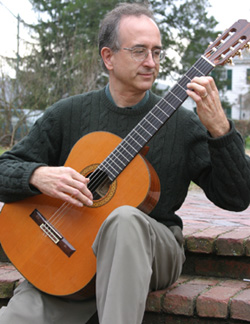Olbrych explores history of guitar on his first CD
“I’ve been doing concerts all my life, but I had nothing to show for
it,” Olbrych said. “For a musician, putting out an album is just like
getting something published. If you want to get more concerts, you’ve
got to have a CD.”
His newly-recorded portfolio, though, is much more than a way
to advertise his expertise—it reflects his individual playing style,
his ideas, and his personality.
“I’ve never seen most of the early pieces on this album
recorded anywhere—the later selections are some of my favorites, the
things I’ve always wanted to record,” Olbrych said.
Whereas many of his colleagues are after the latest and best in
instruments and technology, Olbrych finds himself moving in other
directions, fascinated by the much older and rarer renaissance and
baroque guitars. Along with the more traditional and recent Spanish
guitar—what most folks would be tempted to call a classical
guitar—these 16th and 17th century instruments provide a musical tour
of the guitar’s history.
Differences of sound between the instruments are tangible, made
apparent as Olbrych articulates each with expert precision and inspired
interpretation on his album. Describing the music for each instrument
moves from “a delicate timbre; frilly and ornate” to “a rich sound;
clarity of form.” Every guitar requires a unique technical approach in
tunings, fingerings and plucking. Strumming, however, remains the sole
constant in technique.
The recording will serve as a teaching tool for Olbrych, especially for
students in his classes working on some of the previously unrecorded
material. “My students can listen to exactly how I think the piece
should be played,” Olbrych said with a laugh. There is also the history
lesson inherent in the album; each piece is played and recorded to
sound as close as possible to the way the music of the period was
performed—a challenge requiring more than technique alone to
accomplish.
“I try to approach each piece as thoughtfully as possible,
taking into account the history and philosophies of the time,” Olbrych
said.
With decades of studying, practicing and listening informing
his every performance, there are few better equipped to lead listeners
through 500 years of Spanish guitar. And at the moments where songs
seem to demand impossible feats from his fingers—when notes are played
almost faster than the ear can keep up—Olbrych relies on his experience
to transcend thoughtfulness. “In those moments, you can’t think too
much,” he said.
“That’s where all the years of practice come in and you trust your fingers to do what they’re supposed to do.”
“I can play these songs 50 times, and each time, I find something new that I love about them,” Olbrych said.
Even after playing each piece over and over and over again, Olbrych
never tires of the music. It is what he truly loves—his passion—and it
shows on 500 Years of Spanish Guitar.
Tim Olbrych’s CD, 500 Years of Spanish Guitar, is available at local record, music, and book stores, and on the web at www.timolbrych.com. At age 54, Tim Olbrych decided it was about
time he record an album. So the founder of William and Mary’s guitar
program and performing artist faculty member of the College’s music
department since 1978 picked out 35 guitar pieces spanning five
centuries and just did it. The recently-released result, 500 Years of Spanish Guitar, now serves as Olbrych’s business card.
At age 54, Tim Olbrych decided it was about
time he record an album. So the founder of William and Mary’s guitar
program and performing artist faculty member of the College’s music
department since 1978 picked out 35 guitar pieces spanning five
centuries and just did it. The recently-released result, 500 Years of Spanish Guitar, now serves as Olbrych’s business card.
 Skip to main content
Skip to main content
